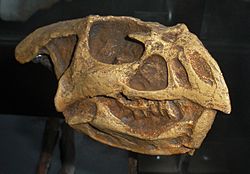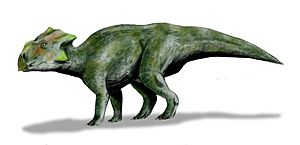Bagaceratops facts for kids
Quick facts for kids BagaceratopsTemporal range: Late Cretaceous
|
|
|---|---|
 |
|
| Skull of Bagaceratops | |
| Scientific classification | |
| Kingdom: | |
| Phylum: | |
| Class: | |
| Superorder: | |
| Order: | |
| Suborder: | |
| Infraorder: | |
| Family: |
Bagaceratopsidae
|
| Genus: |
Bagaceratops
Maryanska & Osmolska (1975)
|
| Species | |
|
B. rozhdestvenskyi |
|
Bagaceratops was a type of dinosaur that lived about 80 million years ago. Its name means "small-horned face." This comes from the Mongolian word Baga (meaning "small") and the Greek word ceratops (meaning "horn face").
This dinosaur lived in what is now Mongolia. Even though Bagaceratops appeared later in the age of dinosaurs, it was quite small. It also had a simple body structure, similar to earlier ceratopsian dinosaurs.
Contents
What Did Bagaceratops Look Like?
Bagaceratops was a small dinosaur. It grew to be about 1 meter (3 feet) long. It stood about 50 centimeters (1.6 feet) tall. This dinosaur weighed around 22 kilograms (48 pounds). That's about the weight of a medium-sized dog!
It had a special bony "frill" at the back of its head. This frill was smaller than in some other dinosaurs. It also did not have any large holes in it. Bagaceratops had ten grinding teeth in each jaw. Its skull was more triangular than its close relative, Protoceratops.
Even though Bagaceratops lived later, it kept many features of older, more basic dinosaurs. Both Bagaceratops and Protoceratops had a beak, like a parrot. They did not have horns above their eyes. Instead, they had a small horn-like bump on their snout.
How Was Bagaceratops Discovered?
The first bones of Bagaceratops were found in the Gobi Desert. This happened in the 1970s. Scientists from Mongolia and Poland were on an expedition together. Two leading scientists, Teresa Maryanska and Halszka Osmólska, described the dinosaur in 1975.
Many Bagaceratops bones are kept at Poland's Paleobiological Institute in Warsaw. Scientists have found five complete skulls and twenty partial skulls. The longest skull found is about 17 centimeters (6.7 inches) long. The smallest young skulls were tiny, only about 4.7 centimeters (1.8 inches) long. This is about the size of a golf ball! Because of these finds, scientists understand well how Bagaceratops grew. Only small pieces of its body bones have been found so far.
Where Does Bagaceratops Fit in the Dinosaur Family?
Bagaceratops belongs to a group of dinosaurs called Ceratopsia. These dinosaurs were plant-eaters. They had beaks that looked like a parrot's. Ceratopsians lived in North America and Asia. They lived during the Cretaceous Period, which ended about 66 million years ago.
What Did Bagaceratops Eat?
Like all ceratopsians, Bagaceratops was a herbivore. This means it ate plants. During the Cretaceous Period, many flowering plants were not widespread. So, Bagaceratops likely ate other common plants of that time. These included ferns, cycads, and conifers. It would have used its sharp, beak-like mouth to bite off leaves or needles from these plants.
Images for kids
-
Fossil localities of Mongolia and the location of Bayan Mandahu; Bagaceratops fossils have been reported from the Bayan Mandahu (bottom right), Hermiin Tsav, Khulsan (both left), and possibly Udyn Sayr (center) localities
See also
 In Spanish: Bagaceratops rozhdestvenskyi para niños
In Spanish: Bagaceratops rozhdestvenskyi para niños







